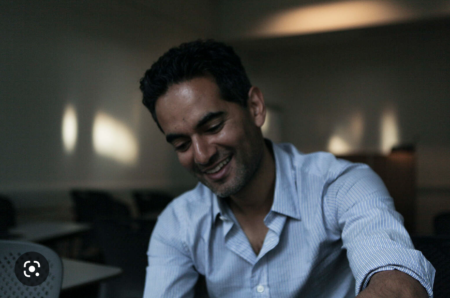A self-described “perennial schoolboy” at heart, Omar Mullick is both romantic daydreamer and pragmatic journalist. It’s in the first few moments speaking with him that I can tell why he is a documentary filmmaker. He loves to indulge in the whimsies and wonders of the world and capture its beauty, but some things need to be rendered in black-and-white. For example, he says, a journalist’s moral code is one and the same with their personal morals: The way he treats a subject in a film is with the same level of respect and humanity that he treats anyone else. In other words, people first, people first, people first.

I had the pleasure of speaking to Mullick about his 2022 documentary “Flight/Risk”, which probed the aftermath of back-to-back crashes of Boeing 737 MAX aircraft, one in Indonesia in 2018 and the second in Ethiopia in 2019. In the two crashes combined, 346 people were killed.
There was no way a doc filmmaker could be on the scene when a crash happens. So Mullick’s decision was to follow several families of crash victims, a whistleblower from Boeing who tried to warn of problems with a new computer system in the MAX and a newspaper journalist, Dominic Gates, who won a Pulitzer Prize for team coverage of coverage of the crashes, the investigation and the insider culture of Boeing.
I interviewed Gates for a previous Storyboard piece about how a print reporter adjusted to being both source and star of Mullick’s documentary film. As aviation beat reporter for The Seattle Times, Gates has distinguished himself as an expert in that field. After the release of “Flight/Risk,” I was curious how he viewed the pros and cons of filmmaking versus print as journalistic mediums. His take: While film can reach a wider audience through more compelling storytelling, it can’t provide the deep detail or context that print can, particularly for complex stories that unspool over time.
That made me wonder what Mullick, as the filmmaker wondered about that perspective. Our conversation has been lightly edited for length and clarity.
How did you become interested in doing a story on the families and people impacted by the 737 MAX crashes?
I like to bring stories back to the lived experience. That’s what documentaries can do. They can catapult you into the point-of-view and empathetic experience of someone actually dealing with the issue at hand — and in a radical way.
What I also find compelling are stories of ordinary people who do extraordinary things. For example, “These Birds Walk” was a film featuring Abdul Sattar Edhi, who ran 70% of Pakistan’s social services and slept amongst the poor in the back of his office in Karachi. A man who worked for him said to me very early on, “It’s not that [Edhi] is extraordinary. He’s an ordinary man, but he has some extraordinary qualities.” I loved that because the film could have been a hagiography or a story that is equally mistrustful to me, which is making Napoleon or some other hero seem like just a regular guy. But I find both those extremes to be dissatisfying. What is compelling to me is that this is a mortal human being who has some extraordinary qualities.
Humans have always been attached to visual storytelling. I think it’s because of that magical moment where you suspend your own disbelief, your own thinking, even if just for an hour or two, and yield yourself to the experience of being in someone else’s shoes. That’s what drew me to tell a story about the families, rather than, for instance, Boeing or just the facts of the story.
I count Dominic Gates as one of those very fine individuals that I’ve been lucky to work with as well.
I imagine you interviewed more families than were featured in the film. How did you decide who would be in the film?
We spoke to a number of families and other people whom we would have liked to include, but some declined to be in the film. Perhaps they did not want to be as public about their stories as a documentary would invite. We were expecting that and I’m very proud that we respected their wishes. People should never feel like they have to participate in a film, no matter how sincere or genuine the film’s goals may be. That might seem obvious, but you’d be surprised how much bad faith you can witness in a documentary project that’s focused on its own ends. So we always supported people’s choice to participate or decline. It demonstrates an integrity around treating people as people first.
When families agreed to be part of the film, did you have to agree to any conditions?
No, but director/producer Karim Amer did something that would make most people’s jaw drop: In the appearance releases he didn’t limit what subjects could later retract. We also did not ask people to sign releases until after filming. I can’t remember how far after filming it was, but I do know that we had already sunk thousands of dollars into the film by that point. That’s what was right for this film. There were so many security concerns over what you could say and what you could be sued for saying that we had to allow people to speak freely and then mitigate later what could be shared. People can’t be expected to be fully aware of the legal parameters around them at all times when they’re speaking for hours into an interview.
What story craft lessons did you learn while making this film that will influence your future works?
I take great joy and satisfaction out of creating a great cinematic piece and taking the facts of a story and making it feel new and alive again for the audience.
What humbled me about this film was that I don’t know if I fulfilled the expectations I originally had to create the great cinematic piece I wanted to make. That usually bothers someone like me.
I did sound and I often shot and directed alone with our producer, Paul McGuire. I really wanted to achieve a new level in my craft. But it wasn’t until I sat and watched the film with the audience that I realized what was really important was that people got the message and the content of the film even without me hitting that bar.
What I realized was that I did create a great film, but perhaps in a different way than I had expected. I might say I did it with a simpler, more straightforward approach — maybe a more honest approach. It met the bar of being a generous and unprecedented piece of cinema. And I know that the journalistic imperative of the story was enough.
It would have been enough to just get the story out there cleanly and simply. But you see, that's the difference between the printed word as in a newspaper, like what Dominic Gates does and what I do.
What else do you see are the strengths and limitations of each medium?
I’m going to piggyback off of what Dominic said because he’s absolutely right: One of the great virtues amongst many of Dominic's works is that he can revisit and stay with this story and build a body of connected knowledge about what happened over years. I, at best, am capturing a moment, especially over a one- or two-year span of shooting. Dominic can go into footnotes and addendums and details, and then he can be rigorous to make sure he fleshes out the argument in a way that satisfies the requirements of academic rigor. Whatever he writes has to be verifiable and fact-checked.
Documentary filmmakers have to do that, too. But I have to weave in the lived experience of the people. I often have to start with the conclusion and give just enough information to pique your interest and allow you to hold that as we build along that 90-minute experience.
That’s really the experience we had with Ed Pierson, the Boeing whistleblower. Ed’s rightful prerogative was to go through, over a period of five days, pages and pages of stuff. Mine was to constantly remind him that I would lift the nuggets or turning points of him arriving at this conclusion to make this the most compelling story, and sometimes what I lift is three things at best. What is as important in my medium is that the audience sees the email and the red mark of your exclamation point next to the lie that was told, and see and hear you holding and reading the email out loud. That is more important in my medium than you just having the information, which you could get from the newspaper alone. My job is to get you red-faced and appalled with it along with us as a lived experience. That means that I am editing more as I shoot than I would be if it was print, and I am weaving a narrative that has to serve the old guard of being rigorously correct but also compelling so that the audience stays with it through the end.
That is the strength of my medium, that someone will get the core message and experience in a lived, visceral way.
* * *
Kristen Chin studied filmmaking at Boston University and now works as a documentary filmmaker and writer.



